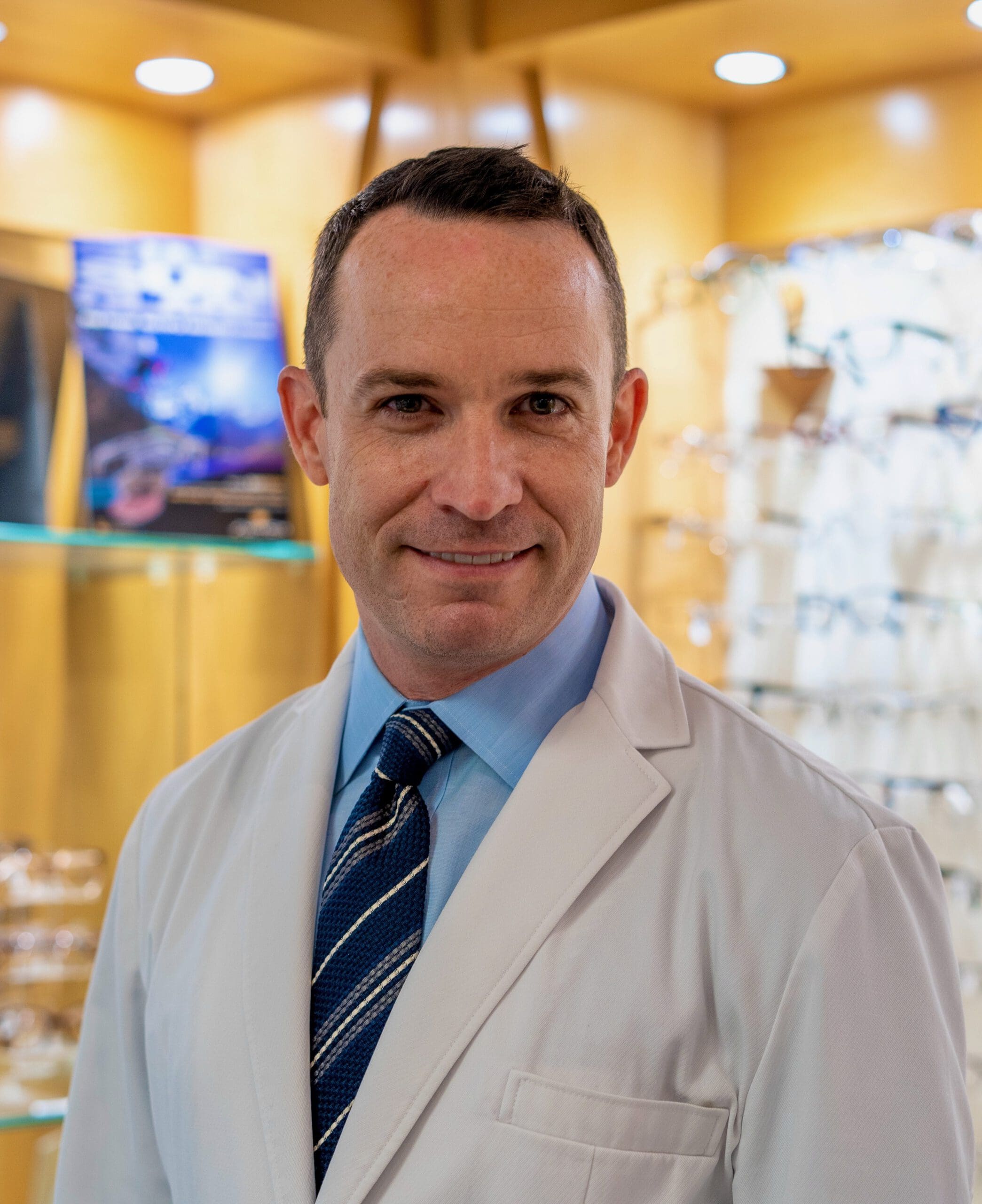
Medically Reviewed by Eric Downing, M.D. NVISION Surgeon
Acute vs. Chronic Glaucoma: When It’s An Attack & Emergency
Home / Diagnosed With Glaucoma /
Last Updated:

Medically Reviewed by Eric Downing, M.D. NVISION Surgeon

Article At a Glance
Glaucoma comes in two main forms: acute and chronic. Chronic glaucoma develops slowly and often goes unnoticed until vision loss occurs. Acute glaucoma is a sudden, painful spike in eye pressure that’s a medical emergency—seek care immediately if you experience severe eye pain, blurry vision, nausea, or halos around lights.
Regular eye exams are essential to catch it early. While both types can cause permanent damage, early detection and treatment—through medications, laser procedures, or surgery—can help protect your vision.
Table of Contents
The most common form of glaucoma is chronic. It develops so slowly that you may not even notice it. Acute glaucoma is different. This form of the disease causes symptoms you can’t ignore.
People with chronic glaucoma may not even notice vision loss for years, and they may never experience discomfort. Those with acute forms of the disease can develop significant pain, nausea, and vision changes.
Glaucoma treatments lower pressure within the eye. Typically, treatment programs start with eye drops. You may also benefit from surgery if the drops do not work.
Acute vs. Chronic: What’s the Difference?

Most people talk about glaucoma as one sight-stealing disease. In reality, this is a disorder that takes many forms. Some come on suddenly, and others are slow to appear.
Open-angle is the most common form of glaucoma, and according to the Glaucoma Research Foundation, 3 million Americans have it. People with this form of the disease:
You deserve clear vision. We can help.
With 135+ locations and over 2.5 million procedures performed, our board-certified eye surgeons deliver results you can trust.
Your journey to better vision starts here.
- Develop problems slowly. Drainage canals from the eye close incrementally, and pressure within the eye begins to rise.
- Have space between eye structures. The “angle” in the name of this disorder refers to the space between the iris and the cornea. An open angle means a channel between these structures is open.
- Live with the disorder indefinitely. Glaucoma in this form can’t be cured. It can only be treated.
When experts discuss “chronic glaucoma,” they are typically referring to open-angle glaucoma. There are other forms of glaucoma that also develop slowly, but they are rare. Open-angle is the most common form of gradual sight loss attributed to glaucoma.
Angle-closure glaucoma is the acute form of the disease. It develops, according to the International Glaucoma Foundation, when eye drainage stops suddenly. Typically, that happens because the iris moves forward and closes the gap between the iris and the cornea. It is a dramatic event, and it’s considered a medical emergency.
What Does Glaucoma Feel Like?
The symptoms you experience due to glaucoma can help you understand whether you are living with an acute or chronic form of the disease.
An acute angle-closure glaucoma attack, according to the American Academy of Ophthalmology, comes with these serious symptoms:
- Blurred vision
- Eye pain you characterize as severe
- Headache
- Nausea and vomiting
- Vision changes, including rainbow-colored spots or circles around lights
Take these symptoms seriously. The Cleveland Clinic suggests calling your eye doctor as soon as they appear. If you can’t get in touch with your doctor, visit the emergency room. Quick action can spare your vision, so it’s critical to ask for help as soon as trouble appears.
Chronic glaucoma, by contrast, comes with no symptoms. In fact, the BrightFocus Foundation says, you might not even notice changes in your vision.
Your eyes tend to compensate for one another, so a stronger eye takes over for a weaker counterpart. If you have glaucoma in just one eye, your other eye may do a significant amount of work. You will not notice anything until the advanced stages of the disease, when your peripheral vision begins to fade.
Chronic glaucoma also causes no pain, even in advanced stages.
Common Glaucoma Treatments

The goal of glaucoma therapy is to reduce pressure within the eye, and that remains true whether you have acute or chronic forms of the disease.
Angle-closure glaucoma is often treated with surgery, says the American Academy of Ophthalmology. These procedures move the iris away from the underlying structures, so your eye can drain properly. Your doctor might choose:
- Iridotomy. A laser cuts a small hole in the iris to allow fluid to escape.
- Iridoplasty. A laser shrinks the iris away from the drainage channel.
- Cataract surgery. If your lens has expanded and is pushing on the iris, replacing it with a synthetic version can help your eye to drain.
- Synechialysis. Your doctor uses tiny tools to pull the iris away from underlying structures.
- Trabeculectomy. A surgeon-created flap in the white of your eye and a bubble inside your conjunctiva allow drainage to happen.
- Drainage optimization. A surgeon-installed drainage tube in your eye collects fluid that is absorbed into the blood vessels.
If these surgical procedures do not amend your glaucoma issue, medications may help. Daily eye drops can help to ease the pressure rising within the eye and keep your optic nerve healthy.
If you have open-angle glaucoma, you may benefit from surgery. Drainage tubes can also help your eye to process liquids. But your doctor might start your treatment plan with eye drops. Each day, you will use these medications to lower pressure and protect your sight.
Both forms of glaucoma are serious, and they can make you fear for your vision. Thankfully, says the Glaucoma Research Foundation, most people with glaucoma do not go blind. About 10 percent of people with glaucoma develop vision deficits due to the disease. But it’s rare for you to develop a complete inability to see.
The closer you follow your treatment plan and use medications as directed, the more likely you will preserve the vision you have now without further losses ahead.
If at any point you feel like your treatment plan is not working, call your doctor. Do not make changes without checking first. Your vision is too important to take lightly.
You deserve clear vision. We can help.
With 135+ locations and over 2.5 million procedures performed, our board-certified eye surgeons deliver results you can trust.
Your journey to better vision starts here.
References
- Types of Glaucoma. (October 2017). Glaucoma Research Foundation.
- Primary Angle Closure (Acute) Glaucoma. International Glaucoma Foundation.
- What Is Chronic Angle-Closure Glaucoma? (September 2019). American Academy of Ophthalmology.
- Glaucoma. Cleveland Clinic.
- How Is Chronic Angle-Closure Glaucoma Treated? (September 2019). American Academy of Ophthalmology.
- How Long Does It Take to Go Blind From Glaucoma? (February 2019). BrightFocus Foundation.
- Understand Your Glaucoma Diagnosis. (October 2017). Glaucoma Research Foundation.

Eric Downing, M.D. is an ophthalmologist and surgeon who treats Cataracts, Diabetes, Age-Related Macular Degeneration, Glaucoma, and Pterygium.
This content is for informational purposes only. It may have been reviewed by a licensed physician, but is not intended to serve as a substitute for professional medical advice. Always consult your healthcare provider with any health concerns. For more, read our Privacy Policy and Editorial Policy.

